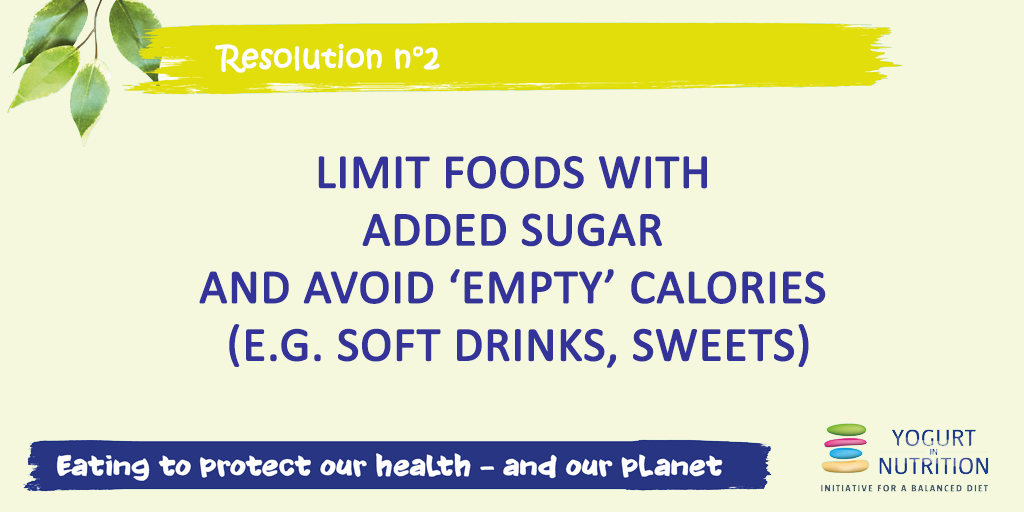At the Yogurt In Nutrition Initiative, we look forward to a more sustainable 2020 and we bring you 12 food resolutions to protect our health and our planet! This month’s resolution for a healthy and sustainable diet: limit foods with added sugar and avoid empty calories.

Soft drinks and sweets can be consumed as occasional treats, but from a sustainable point of view they have too many calories without many nutritional benefits when consumed daily.
Among all existing recommendations for a more healthy and sustainable diet, limiting added sugars came out quite frequently. The recent FAO and WHO “Sustainable healthy diets guiding principles” states that 2 billion suffer from micronutrient deficiencies. By choosing a variety of nutrient-rich foods in our daily diet while limiting “empty-calorie” foods, we can adjust our nutrient intake with an adapted energy density. Eating more fruits, vegetables, legumes, nuts… and lower amounts of sugars and meat contribute to a healthier diet.
About nutrient-density…
Nutrient density can be defined as a measure, for a food product, of the quantity of nutrients provided per calorie of food. It is a way to estimate the concentration of nutrients per amount of food. A nutrient-dense food will provide higher concentration of macro and micro-nutrients (like proteins, fibers, vitamins, minerals…) relative to calories. For the same amount of calories, a nutrient-rich food or beverage provides a larger diversity and/or quantity of nutrients whereas an empty-calorie food or beverage will carry mainly energy but is a poor source of nutrients.
… and food matrix
As a diet is not just about single nutrients, the food structure may also affect the nutrient absorption. The food matrix generates interactions, which may modify the properties of nutrients. For instance, due to the lactic acid bacteria activity, the dairy matrix of yogurt facilitates nutrients absorption and affects the appetite and the glycemic control. Yogurt also provides nutrients to encourage (calcium, zinc, potassium, vitamins, phosphorus, proteins), while being low on calories and sodium. It is a perfect example of nutrient-rich food.
A few tips to limit avoid empty calories
Switching to a flexitarian diet, with nutrient-rich foods and limited added sugars, may reverse the rise in our consumption of sugar, fats, salt and mass-produced products, according to the WWF.
If this resolution is something you want to work on, read below a few tips to help you with this challenge!
- Encourage wholegrains including wheat, brown rice, oats, barley or corn instead of refined grains.
- Choose safe and clean drinking water rather than sugar-sweetened beverages
- Vegetable choices over time should vary and include many different vegetables, with limited additions such as salt, butter, or creamy sauces.
- At least half of the recommended amount of fruits should come from whole fruits. Make your own 100% fruit juice to replace soft drinks.
- Protein will create satisfying meals and meet nutrient body needs. This includes lean meats, poultry without skin, seafood, fish and eggs but also plant-based proteins like beans and lentils.
- Consume dairy products: whole-fat or low-fat dairy including milk, yogurt or cheese
- Reduce progressively your refined sugar consumption. Chose fruits rather than a sweet cake for dessert or try dried fruits instead of candy.
- Try to stop buying convenience food! Try out some traditional recipes.
For more information, check out our Q&A about sustainable diets and our infographic on nutrient-rich foods for a healthier diet:
- What would a more sustainable diet means for you?
- What is a flexitarian diet?
- Switching to nutrient-rich foods for a healthier diet
- What is nutrient-density?
Sources:
-
Willett W, Rockström J, Loken B, et al. EAT-Lancet Commission Summary report: Food in the anthropocene: the EAT– Lancet Commission on healthy diets from sustainable food systems. Lancet. 2019;393 (10170):447-492.
-
WWF (UK). Eating for two degrees. 2017.
-
WWF France. Towards a low carbon, healthy and affordable diet. 2018.
-
FAO & WHO. Sustainable healthy diets guidelines principles. 2019.
-
WHO 2015. Guideline: Sugars intake for adults and children.



